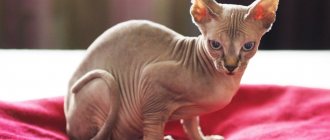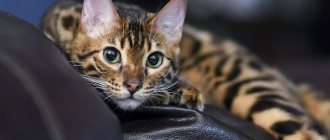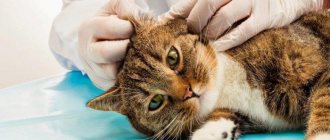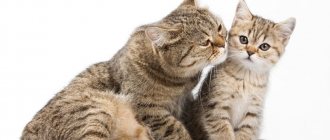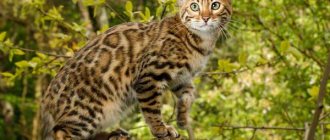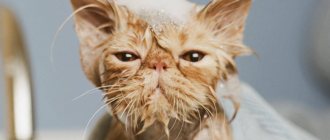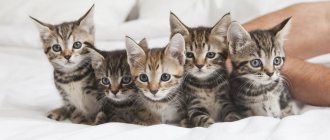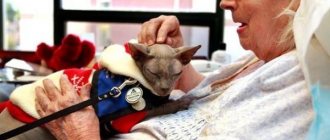Why do you need to measure your cat's height?
Even if your cat leads a purely indoor lifestyle, she will need clothing in cold weather. This applies, first of all, to smooth-haired pets, who are especially cold on autumn days, when the central heating has not yet been turned on in the apartment.
You can sew a cat costume yourself or buy a finished product at a pet store. In both cases, so that the new thing does not turn out to be too small or large, you first need to take measurements from the animal.
In addition, height is measured in purebred animals that participate in exhibitions. Its value serves as the basis for calculating the index of elongation, massiveness, long-leggedness and other parameters of the animal. By comparing these values, a panel of judges determines whether a given specimen meets the required breed standards.
Flaws
Disadvantages during participation in exhibitions include even the slightest squint in a cat. Depressions between the eyes and snub nose of the cat are also unacceptable. The nose of an Oriental cat must be long and straight, without forming any fractures at the intersection with the forehead.
The disadvantage of a cat may be excessive massiveness of the chin and jaw.
The only disadvantage of the breed is that there is a huge list of correct construction of an Oriental cat, which makes the goal of winning the competition even more difficult to achieve.
What types of body structure do cats have?
Compared to dogs, domestic cats differ little from each other in shape and size. However, the existing differences distinguish three main types of these animals:
- Undersized . Short-legged cat breeds, the most famous of which is the Munchkin. The paws of these animals are 2-3 times shorter than usual, which is due to the dwarfism gene. Height - up to 20 cm.
- Medium height . Cats with well-developed muscles, slightly rounded heads and medium-sized legs. Height – from 23 to 30 cm.
- Tall . The most famous breeds are Savannah and Maine Coon. Slender, long-legged animals with a narrow chest and wedge-shaped head. Height – up to 45-60 cm.
Description of the Oriental cat
Although Oriental cats owe their origin to Siamese, it is impossible to confuse them with each other. Representatives of these two breeds are too different in appearance and character.
Breed standard
Before you decide to have an Oriental cat at home, it is useful to study in detail the description of this breed.
Table - Oriental cat breed standard
| Head | Long, narrow, triangular in shape |
| Eyes | Oval, medium in size, slightly inclined towards the nose, widely spaced |
| Nose | Smooth, smooth transition from forehead to nose |
| Muzzle | Sharp, wedge-shaped |
| Ears | Large, triangular, not rounded |
| Body | Thin, elongated, muscular |
| Neck | Long, slender |
| Paws | Tall, slender, proportional to the body |
| Tail | Thin, long, with a pointed tip |
From one glance at the Orientals, it becomes clear that these animals are graceful and slender. The movements of these pets are soft and smooth. These are the elegant aristocrats of the cat world.
It’s hard to believe, but for all their grace and smartness, Orientals can have considerable size and weight. Males weigh on average 3.5-4.5 kg, cats - 2.5-3.3 kg. Height at the withers can reach 25-35 cm, body length - up to 90 cm.
Oriental cats come in short-haired and long-haired varieties. The second variety of the breed was developed later, around the end of the 20th century.
One of the hallmarks of St. Petersburg is the breed of hairless domestic cat created here. Such animals are called Peterbalds or St. Petersburg sphinxes. This breed is the result of a “love affair” between an Oriental cat and a Don Sphynx.
In the photo there is a cat of the Peterbald breed (Petersburg Sphynx)
Some defects can spoil the aristocratic appearance of Orientals, for example:
- any other eye shade other than green;
- strabismus;
- protruding cartilage in the sternum area.
Excessively thin and small Orientals, those with extra toes (polydacts), and cats with kinked tails will not be allowed to attend the exhibitions.
Defects are also considered to be underdeveloped hind legs of cats and breathing through the animal's mouth.
Varieties of colors
Breeding work has made it possible to develop many possible colors of Orientals - about 45. The most popular fur colors of such animals are considered to be:
- Havana. The coat and nose are brown, the paw pads are pinkish-brown.
- Blue. Gray-blue fur evenly covers the entire body of the animal, including the tail and nose.
- Lavender. The gray coat of the animals seemed to be slightly touched by a touch of frost (without turning blue). The paw pads and nose are purple.
- Ginger. The fur is a rich red hue, pink paw pads and nose.
- Faun. The beige or light gray fur harmonizes with the pink nose and paw pads.
- Cinnamon. Light brown coat combined with pink nose tip and paw pads.
- Black.
- White.
Oriental colors are not only monochromatic. It is not uncommon to see marbled or brindle-colored animals or ticked tabbies. Such individuals are a rare breed. At competitions, these animals receive special attention.
Character of an oriental cat
Cats from the East are self-sufficient, energetic and persistent in their habits. They have a hard time with a change of place of residence or owners. Orientals require a lot of attention and do not tolerate being ignored. To attract the attention of a biped, relatives of Siamese cats are able to literally follow on its heels while cooking, cleaning and even resting.
Oriental cats get along well with cats of other breeds and can even get along with dogs.
One of the advantages of Orientals is their lack of aggressiveness. When playing with children, these animals take care of their teeth and claws so as not to inadvertently scratch or bite “human cubs.” These animals simply adore guests, easily win everyone’s attention and always try to be the center of attention.
Long-eared cats are active and curious. They love to play, run and explore around the house. These long-legged beauties will certainly open all the cabinets and doors that they can reach, take out and study the things that interest them.
On a note. Oriental cats are talkative creatures. There is a myth that their voice is unpleasant and harsh, but this is not entirely true. Orientals not only meow, but also purr melodiously. Their voice is really unusual, but certainly not unpleasant.
Health and life expectancy of Orientals
"Thais" are considered cats with good health. But they are also susceptible to some diseases, for example:
- Gingivitis is a disease of the oral cavity. A sick animal stops eating and has severe salivation. This pathology can be prevented by regularly brushing your pet's teeth.
- Diseases of the gastrointestinal tract and liver.
- Retinal atrophy. It will be very difficult for the owner to track this disease on their own. The cat should be taken to the veterinarian regularly. Using special equipment, the doctor will make a diagnosis and adjust the treatment.
- Flat chest syndrome. Kittens are susceptible to this disease. The problem may disappear on its own as the animal grows, and the kitten will turn into an adult cat. If this does not happen, the little oriental dies.
- Heart diseases.
Most diseases can be prevented if you visit the veterinarian on time and give your pet all the necessary vaccinations.
Provided full care is taken for the health of an Oriental cat, these animals can live 15-17 years.
Height or length?
Our smaller brothers walk on four legs, which creates some confusion when taking measurements. What is the difference between a pet's height and its body length?
A cat's height is measured vertically. The withers are taken as the starting point - the border between the cervical and dorsal spine, the highest part of the back. The center of the withers is located at the point between the shoulder blades of the front legs; this place is covered by a particularly dense fold of skin. The cat holds the cat by the withers (in common parlance, by the scruff of the neck) during mating, and the cat drags the newborn kittens.
As for body length, its value is measured in the horizontal direction.
Let's start taking measurements
Measuring the height of a cat is more difficult than measuring the height of a dog. A standard cat will not stand in one place for even a couple of minutes, so to take measurements you will need an assistant to hold the fidget.
Who is not suitable for an Oriental breed cat?
Magnificent Orientals are, alas, not the kind of cats that walk on their own. For games and walks, they certainly need a companion who will devote all their time (or at least most of it). Therefore, before getting these cats, the owner should think about how much free time he has. An abandoned cat will quickly become bored and depressed.
It is also worth considering that the Cat-Big-Ears, who wants to get his way, will meow persistently and persistently. This will not be to the taste of all owners.
The Oriental cat is one of the few hypoallergenic breeds. So people who suffer from allergies to cat fur can safely have these pets in their home.
The owner of an Oriental will never be able to say that an ordinary pet lives in his house. Cats of this breed are beautiful, talkative and loyal. For a person who is able to give his pet his time and attention, such an animal will become a true friend and companion.
Petstory app – a service for cat owners
When a pet shows symptoms of deteriorating health, loving owners rush to look for information on the Internet. However, the information that can be gleaned from there often contradicts each other. It is much more convenient to consult with a qualified veterinarian at the first warning signs and get competent advice on what to do next.
To take advantage of this opportunity, install the Petstory mobile application on your smartphone. The service allows you to consult online with experienced veterinarians, and you choose a specific specialist yourself.
Types of split systems
Depending on the design features and functional purpose, there are several types of split systems: wall-mounted, floor-ceiling, duct, cassette, column and multi-split systems.
Wall-mounted air conditioners
- this is the classic and most popular type of split system, consisting of two working units: the outer one is taken out into the street, and the inner one is usually hung on the wall of the room.
Wall-mounted split systems have a power from 2 to 8 kW
, so they are suitable for small
rooms up to 100 sq.m.
They are equipped with a standard set of functions, are compact and easy to use, and are controlled remotely using a remote control.
If the task is to equip a large room with climate control equipment, then floor-ceiling split systems
.
Air conditioners of this type are universal, they can be installed on the floor or ceiling
of the room, and the second option provides for two types of installation - open or built into a suspended ceiling.
If the split system is located on the floor, then the air stream moves up the wall; with a ceiling installation, the flow rushes along the ceiling and is then evenly distributed throughout the room. Floor-ceiling devices can operate effectively on an area of up to 180 sq.m.
An excellent option for rooms with a large area and high suspended ceilings - cassette and duct split systems
.
Both of them are built into the interceiling space of suspended ceilings
, and only decorative grilles are taken outside.
Cassette split systems
distribute cold air flows more evenly in the room, since their design is square in shape, and depending on the model, air blows from 2, 3 or 4 sides. Duct air conditioners are the most difficult to install, as they always require the design and installation of an air duct. But at the same time, this is a very convenient option for arranging cooling/heating of several interior spaces at once.
Air flow distribution diagram in cassette split systems
Column split systems
are installed on the floor and resemble a large refrigerator in appearance.
The air flow is directed upward
, from where it is distributed over the entire area.
They are also suitable for larger rooms
. Usually they are installed if, due to the design features of the room, it is impossible to equip it with another type of split system.
Unlike the above types, multi split systems
consist of several working blocks.
One of them is external, which can simultaneously serve from 4 to 8 indoor units.
This is very convenient when you need to install air conditioners in several rooms at once, but you don’t want to spoil the façade of the building with additional equipment. Both the same type and different types of split systems can be connected to the indoor unit, and for each of them you can set an individual operating mode.
Power and dimensions of serviced premises for different types of split systems
How to determine the size of a cat's clothing correctly
To correctly determine the size of clothing, the cat is measured. You will need a tailor's measuring tape. If this is not available, use a piece of non-stretchable twine. Due to its short length and inflexible material, a ruler is not suitable.
The measuring tape may show incorrect results when the markings are not applied correctly (a common defect in measuring tools purchased from the Chinese marketplace). Or the tape has stretched or shrunk during use.
Before taking measurements, you need to check the accuracy by comparing the measurement with a school ruler (preferably a Soviet model - at that time all measuring instruments were checked for measurement accuracy).
Design and principle of operation of a split system
Unlike classic air conditioners, which were inserted into a window and had only one working unit, split systems consist of two units
: external and internal. The street block is usually placed on the outer wall of the building, less often on the roof. Internal - remains in the room, and depending on the type of split system, is installed on the wall, floor or ceiling of the room. The blocks are connected to each other using copper tubes of various diameters.
Split system device
The diagram shows that the indoor unit consists of an evaporator, from where freon is sent under low pressure to a compressor located in the outdoor unit. Here the gas is compressed and heated to 80 degrees and then enters the condenser, blown by a fan. In the condenser, the gas turns into liquid and is sent to the expansion valve, where it cools and its pressure decreases. It then enters the evaporator and again turns into a gaseous state, taking heat from the room and thereby cooling the air. Then the cycle repeats again.
Most modern split systems work
not only
for cooling
, but
also for heating.
The operating principle remains the same, but due to the built-in valve, the freon movement pattern changes, and in this case the blocks seem to change places: the outer one cools the air, and the inner one heats it.
How to take measurements
When a cat sits or lies, the spine changes length due to deflection or twisting. Clothing for a cat is designed for movement, so measurements are taken after placing the animal.
It is better to measure together. The owner calls the cat, holding a treat in his palm. The palm of the other hand gently supports the stomach, preventing the animal from sitting down.
At this time, the assistant measures:
- the length of the back from the withers to the beginning of the tail (not the end of the body);
- neck circumference (the tape is placed in the middle);
- chest volume (widest point);
- volume of the abdomen (when the cat is expecting kittens, or the pet is well-fed).
Common clothing models are blouses with an elongated back or blankets with a hole for paws without sleeves. When you plan to purchase items with sleeves and legs, the circumference (volume) of the paws is measured.
- The cat stands on four legs, head slightly raised (standard stance).
- The tape wraps around the front legs at chest level just behind the limbs.
- To measure the hind legs, the tape is run parallel to the floor from the level of the groin towards the tail.
- If trousers are purchased, measure the length of the leg from the root of the tail to the desired length (usually the hock).
Clothes for kittens are purchased for growth. It is better to check the measurement table for this breed, which records growth by month. Or purchase clothes by adding up to 4 cm for movement.
History of the construction of modern St. Isaac's Cathedral
The cathedral did not at all correspond to the status of the capital. Therefore, less than seven years had passed before a competition for the construction of a new one was announced. Alexander the First set the condition for the preservation of the three altars that existed previously. One by one, the king rejected the proposed projects. In the end, the young French architect Montferrand was assigned to develop the project. At the beginning of 1818, the project was approved by the Tsar.
A special commission was created to supervise the construction, and in 1819 the first stone was laid.
However, soon the famous architect A. Maudui criticized the project. His main comments boiled down to the fragility of the foundation and the incorrect design of the main dome. The project had to be redone and refined, but all comments were taken into account. Only in 1825 the project was finally approved, and construction of the cathedral continued. It ended after 40 years.
On May 30, 1858, the consecration of the new temple took place in the presence of the royal family.
By the way, the height of St. Isaac's Cathedral and the Bell Tower of Ivan the Great in Moscow was considered the most significant at that time.
size table
Manufacturers conventionally divide all cat breeds into large, medium and small (L, M, S), and then make a breakdown in increments of 3-5 cm, referring to the control measurement of neck girth. Before purchasing, it is worth checking whether the table includes allowances for loose fitting - after all, the cat does not need tight-fitting clothes.
A couple of cm are added to the measured home values for freedom of movement of the animal, then the size is determined from the table.
Important: the choice of size also depends on the type of fabric. If the control measurements with an increase were obtained on the border of two sizes, choose the smaller one when the fabric stretches well (for example, knitted fabric, lycra, jeans with elastane).
If the table determines the size of the cat, and the planned purchase is a jumpsuit worn on four paws, additionally measure their girth.
Kitten weight table by age
The size of a Bengal kitten reflects its health. Cubs with congenital defects, parasitic diseases, genetic abnormalities, and those with poor nutrition develop poorly.
To promptly identify deviations from the standard, the owner must weigh the kitten regularly. In the first weeks of life, weighing should be daily, then twice a week.
The normal weight of a Bengal kitten at different stages of life is shown in the table.
| animal age, months | average normal body weight, kg |
| first week after birth | 0,08–0,12 |
| 1st month | 0,4–0,5 |
| 2–3 | 0,8–2,4 |
| 4–5 | 2,7–3,6 |
| 6 | 3–3,8 |
| 7 | 4 |
| 8–9 | 4,2–6 |
| 10–12 | 4,5–6 |
A newborn Bengal kitten weighs 80–120 g, but after a week this figure doubles.
Recommendation! If a newborn kitten feeding on mother's milk is not recovering well, then the nursing cat should be given more protein and vitamin food.
The kitten is gaining weight unevenly. Once the baby reaches 2 months of age, its growth slows down. But as soon as its weight exceeds 1 kg, development becomes rapid again. By 7–9 months of age, body development and mass accumulation are once again inhibited.
In females, growth acceleration is no longer observed; body size remains almost unchanged. But males resume active development until 2 years of age.
Shoe size
To find out which shoes are suitable for a cat, you need to take standard measurements of the length and width of the “feet”. The easiest way is to put your pet on a piece of paper and trace the front and back tracks. Afterwards, in a calm environment, without torturing the animal, you can determine the size of the shoes.
Important: paws, in most cases, differ in size from each other, so you should not rely on single readings.
Clothing for a cat is not a whim of the owner, but a necessity: hairless breeds are cold, short-haired ones need warmth when they are acclimatizing or sick. To prevent the fur from becoming electrified, when choosing clothes for a cat, preference is given to natural fabrics with a small synthetic content.
Education and training
Oriental cats are smart and quick-witted animals, but it is also very important to raise them correctly. The best approach to this matter is the “carrot and stick” method. The requirements must be followed very strictly. If the owner has forbidden you to do something, then the pet should not be allowed to do it next time. Otherwise, the cat will eventually start doing whatever it wants, for example, damaging objects in the house, “traveling” on curtains, or using flower pots instead of a toilet. To avoid such incidents, raising a pet should be done from a very early age.
Under no circumstances should you use physical force on an animal.
This approach can damage the psyche of an Oriental and he will turn from a pet into an enemy. Cats of this breed very clearly track the intonation of the human voice. Therefore, a demanding tone in your address will be enough.
If your pet wants to play pranks, it is useful to distract his attention by offering some kind of game. It is not difficult to entertain an Oriental; he will be happy to play even with an ordinary piece of paper if enthusiastic spectators are looking at him.

